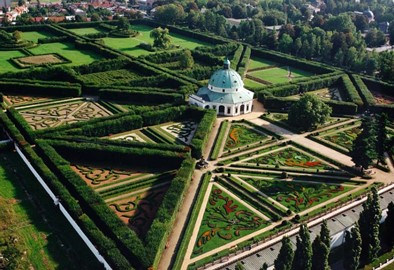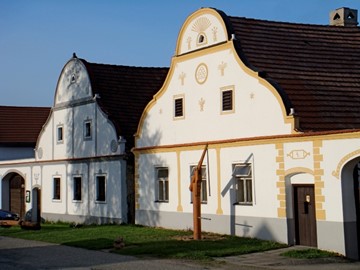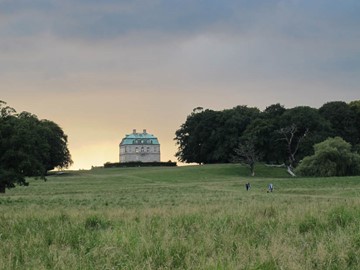category :: cultural
Choirokoitia
Choirokoitia, a UNESCO World Heritage site in Cyprus, is a well-preserved Neolithic settlement dating back to 7000 BCE. Featuring circular stone houses, defensive walls, and ancient artifacts, it offers a rare glimpse into one of the Mediterranean’s earliest human communities. This archaeological treasure highlights prehistoric life and early architectural ingenuity.
Cesky Krumlov
Cesky Krumlov, a UNESCO World Heritage site in Czechia, is a picturesque medieval town nestled along a river, famed for its well-preserved Gothic, Renaissance, and Baroque architecture. Dominated by a grand castle, its cobblestone streets and colorful buildings reflect centuries of European history. This charming site offers a captivating blend of cultural heritage and scenic beauty.
Telc
The Historic Centre of Telč, a UNESCO World Heritage site in Czechia, is renowned for its well-preserved Renaissance and Baroque architecture. This picturesque town features a charming market square lined with colorful burgher houses, arcades, and gabled facades, reflecting its 16th-century prosperity. The nearby Telč Château, a masterpiece of Renaissance design, adds to the site's cultural significance. Its harmonious layout and historical authenticity make it a standout example of Central European heritag... Read More
Pilgrimage Church of St John of Nepomuk
The Pilgrimage Church of St John of Nepomuk, a UNESCO World Heritage site in Czechia, is an architectural masterpiece built in the early 18th century to honor the revered saint. Designed by Jan Blazej Santini, it features a unique star-shaped layout symbolizing the five stars associated with the martyr, blending Baroque and Gothic styles seamlessly. Its intricate design, including five gates, chapels, and altars, reflects deep religious symbolism and Santini’s innovative vision. Recognized in 1994, it stand... Read More
Kutna Hora
Kutná Hora, a UNESCO World Heritage site in Czechia, is a historic town renowned for its well-preserved medieval architecture and rich cultural legacy. Once a thriving silver mining center in the Middle Ages, it boasts landmarks like the Gothic St. Barbara’s Church, adorned with intricate frescoes, and the Sedlec Ossuary, a unique chapel decorated with human bones. Its historical significance and architectural treasures make it a fascinating destination, offering a glimpse into Europe’s past.
Lednice Valtice
The Lednice-Valtice Cultural Landscape, a UNESCO World Heritage site in Czechia, is a remarkable example of a designed landscape crafted by the Liechtenstein family between the 17th and 20th centuries. It features two stunning chateaux—Lednice, with its Neo-Gothic architecture, and Valtice, a Baroque masterpiece—set amidst an English-style park adorned with romantic follies, ponds, and rare tree species. Recognized in 1996, this site blends Baroque, Neoclassical, and Neo-Gothic styles, showcasing a harmonio... Read More
Holy Trinity Column in Olomouc
The Holy Trinity Column in Olomouc, a UNESCO World Heritage site in Czechia, is an ornate Baroque monument erected in the early 18th century to celebrate faith and resilience after the plague. Towering over a historic square, its intricate sculptures and golden details exemplify Central European artistry. This striking column stands as a testament to religious devotion and architectural skill.
Kromeríz Castle and Gardens
Kroměříž Castle and Gardens, a UNESCO World Heritage site in Czechia, exemplify a well-preserved Baroque princely residence and its associated landscapes. The castle, originally a Gothic structure transformed in the 17th century, features ornate interiors and a renowned art collection, while the adjacent gardens include the formal Baroque Pleasure Garden and a romantic 19th-century English-style park. Recognized in 1998, this site showcases a harmonious blend of architecture, art, and nature, reflecting cen... Read More
Holasovice
Holašovice, a UNESCO World Heritage Site in Czechia, is a well-preserved historic village renowned for its unique South Bohemian Folk Baroque architecture. Dating back to the medieval period, it features a collection of 18th- and 19th-century farmsteads arranged around a central green, showcasing a blend of vernacular building traditions. Inscribed in 1998, the village offers a rare glimpse into traditional Central European rural life, with its intact layout and cultural significance drawing visitors to its... Read More
Litomysl Castle
Litomyšl Castle, a UNESCO World Heritage Site in Czechia, is a stunning example of a Renaissance arcade castle, constructed between 1568 and 1581 for the Pernštejn family. Its unique sgraffito-decorated exterior, featuring over 8,000 intricate designs, and elegant arcades reflect Italian influences adapted to Central European style. The castle also boasts an 18th-century Baroque theater and luxurious interiors, earning its place on the UNESCO list in 1999 for its architectural significance and historical pr... Read More
Tugendhat Villa
Tugendhat Villa, a UNESCO World Heritage site in Czechia, is a masterpiece of modernist architecture designed by Ludwig Mies van der Rohe and Lilly Reich in 1928–1930. Built for Fritz and Greta Tugendhat, it showcases innovative spatial design, functionalism, and industrial materials like reinforced concrete and large glass windows, embodying the 'less is more' philosophy. Its open interior, luxurious materials such as onyx and tropical woods, and seamless connection to the outdoors redefined modern living.... Read More
Prague
The Historic Centre of Prague, a UNESCO World Heritage site in Czechia, is a stunning medieval cityscape blending Gothic, Baroque, and Romanesque architecture. Known for its iconic castle, astronomical clock, and charming cobblestone streets, it reflects centuries of European history. This well-preserved urban jewel offers a captivating showcase of cultural and architectural richness.
Trebic Jewish Quarter
The Třebíč Jewish Quarter in Czechia, a UNESCO World Heritage site since 2003, is one of Europe’s best-preserved Jewish ghettos, showcasing centuries of cultural history along the Jihlava River. Its 123 historic houses, two synagogues, and expansive cemetery with over 3,000 graves reflect a unique blend of architectural styles and Jewish traditions. Paired with the nearby St. Procopius Basilica, this site exemplifies the peaceful coexistence of Jewish and Christian communities from the Middle Ages until Wor... Read More
Koguryo Tombs
The Complex of Koguryo Tombs, a UNESCO World Heritage site in Korea, is a collection of ancient burial sites from the Koguryo Kingdom, dating back to the 1st century BCE to 7th century CE. Adorned with vivid murals depicting daily life and mythology, these stone tombs showcase exceptional artistry and architectural skill. This site offers a rare window into an influential early East Asian civilization.
Kaesong
Kaesong, a UNESCO World Heritage site in Korea, is a historic city renowned for its well-preserved cultural and architectural legacy. It served as the capital of the Koryo Dynasty (918–1392), showcasing traditional Korean urban planning, ancient palaces, and tombs. The site includes notable landmarks like the Kaesong Namdae Gate and the Koryo Museum, reflecting its significance as a center of trade, education, and ginseng production. Recognized by UNESCO in 2013, Kaesong offers a glimpse into Korea’s rich m... Read More
Roskilde Cathedral
Roskilde Cathedral, a UNESCO World Heritage site in Denmark, is a stunning example of Gothic architecture, renowned for its historical and cultural significance. Constructed primarily in the 12th and 13th centuries, it served as the burial place for Danish monarchs, housing an impressive collection of royal tombs. The cathedral’s distinctive red-brick design, twin spires, and intricate interior, including the ornate Christian IV Chapel, reflect centuries of architectural evolution and artistry. Today, it st... Read More
Kronborg Castle
Kronborg Castle, a UNESCO World Heritage site in Denmark, is a magnificent Renaissance fortress renowned for its historical and cultural significance. Built in the late 16th century, it served as a strategic stronghold and royal residence, famously inspiring the setting of Shakespeare’s Hamlet. Its well-preserved architecture, including grand halls and intricate defenses, reflects Denmark’s rich heritage. Today, it attracts visitors with its captivating history and stunning coastal views.
Moravian Church Settlements
Christiansfeld, a UNESCO World Heritage site spanning Germany, the USA, the UK, and Denmark, is a well-preserved 18th-century Moravian Church settlement known for its simple, harmonious architecture. Featuring uniform brick houses, a central church, and planned streets, it reflects the Moravian ideals of community and piety. This historic site offers a glimpse into a unique Protestant utopian vision.
Par Force hunting landscape
The Par Force Hunting Landscape in Denmark, a UNESCO World Heritage site since 2015, is a meticulously designed cultural landscape from the 17th and 18th centuries, created for royal par force hunting—a practice where hounds and riders chased game to exhaustion. Spanning forests and hunting grounds, it features a distinctive star-shaped network of lanes, numbered stone posts, and a Baroque hunting lodge, reflecting the era’s landscaping principles and the absolute power of Danish monarchs over nature. Today... Read More
Kujataa
Kujataa, a UNESCO World Heritage site in Denmark, is a sub-arctic farming landscape in southern Greenland that showcases the intertwined histories of Norse and Inuit cultures. Inscribed in 2017, it highlights over a thousand years of agricultural adaptation to the harsh Arctic environment, beginning with Norse settlers in the 10th century who introduced farming practices, followed by Inuit communities who blended farming with marine hunting. The site features archaeological ruins, modern sheep farms, and ev... Read More
Aasivissuit – Nipisat
Aasivissuit – Nipisat, a UNESCO World Heritage Site in Denmark, is a cultural landscape in western Greenland that preserves over 4,200 years of human history. It showcases the Inuit’s seasonal hunting traditions, with well-preserved archaeological remains from the Saqqaq, Dorset, and Thule cultures, as well as traces of 18th-century colonial settlements. Recognized in 2018, this site highlights sustainable land use and the resilience of human adaptation to the Arctic environment, featuring ruins, hunting sy... Read More
Jelling Mounds
Jelling Mounds, a UNESCO World Heritage site in Denmark, is renowned for its significant historical and cultural value. The site features two large rune stones, a church, and burial mounds dating back to the 10th century, marking the transition from paganism to Christianity in the region. The larger rune stone, erected by King Harald Bluetooth, celebrates the unification of Denmark and the spread of Christianity, making it a key artifact of Viking Age history. Today, Jelling stands as a well-preserved testa... Read More
Santo Domingo
Santo Domingo, a UNESCO World Heritage site in the Dominican Republic, is renowned as the first European settlement in the Americas, founded in 1496 by Bartholomew Columbus. Its historic Colonial City features well-preserved 16th-century architecture, including the Cathedral of Santa María la Menor, the oldest cathedral in the Americas, and the Alcázar de Colón, a former residence of the Columbus family. The site showcases a blend of Spanish colonial influence and Taino heritage, offering a glimpse into the... Read More
Quito
Quito, the capital of Ecuador, is a UNESCO World Heritage site renowned for its well-preserved colonial architecture and rich cultural history. Founded in the 16th century on the ruins of an Inca city, it boasts one of the best-preserved historic centers in Latin America, featuring ornate churches, monasteries, and cobblestone streets. Its location high in the Andes adds to its unique charm, blending indigenous and Spanish influences seamlessly. The city’s cultural significance and historical integrity earn... Read More
Santa Ana de los Ríos de Cuenca
Santa Ana de los Ríos de Cuenca, a UNESCO World Heritage site in Ecuador, is a well-preserved colonial city founded in 1557, renowned for its historical architecture and cultural significance. Its urban layout, featuring narrow cobblestone streets and whitewashed buildings with red-tiled roofs, reflects a blend of Spanish and indigenous influences. The city’s designation in 1999 highlights its role as a testament to colonial planning and its enduring heritage, making it a key cultural landmark in South Amer... Read More
























